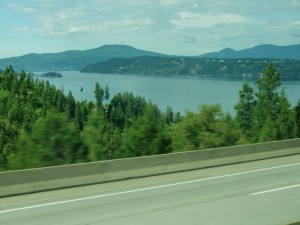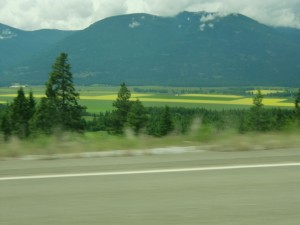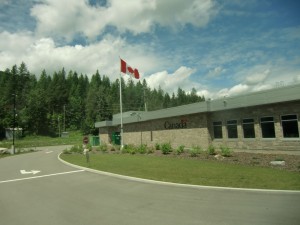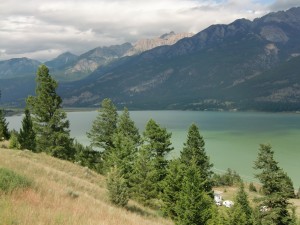EXPLORING THE ROCKIES – ENTERING CANADA
EXPLORING THE ROCKIES
This is the second in a series of articles about traveling in the Canadian Rockies
ENTERING CANADA
By Charles N. Stevens
Photos by Dolores Seidman
The ominous clouds of yesterday have been swept away to the east, leaving the sky magnificently clear. Everything is brighter, the forested hills greener, the sky bluer. After breakfast we wander out into the crisp air, enjoying its freshness. We talk to a group of men who are riding recumbent bicycles, using a paved-over railroad bed, now called the Coeur d’Alene Trail, as a path to ride through the forests. Dolores and I take a long walk on a pathway through a park, the early sun backlighting the heavy dew on the grass. Blackbirds and swallows dart over the wet grass.
Our tour bus is on its way shortly after eight, rolling along I-90 again. As we are backtracking for a while, we again pass Lake Coeur d’Alene, this time appearing much bluer. We pass healthy, lush forests alternating with green meadows where cows graze lazily.
As we head north on Highway 95 we pass through a section of “American Ugly”, the usual stores one finds anywhere—Kohl’s, Target, Walmart, and Panda Express along with car dealers, gas stations and fast food restaurants. Leaving “civilization” behind, the bus enters a wide valley where more forests vie with open grassy fields. I note a large Boise-Cascade lumber mill where stacks of cut lumber, some of it wrapped for protection, wait to be loaded on railroad cars. We share the road with numerous logging trucks carrying huge scruffy logs. I notice where land had been cleared for logging that small conifers are growing like weeds, the forests regenerating. I relax and gaze out the window at the iron-colored mountains with fleecy clouds floating along their ridges. Miles and miles of old and new forests grow on both sides of the road with only an occasional farm occupying a cleared section, some with the standard red barn and silver silos.
The sky becomes overcast again as we skirt Lake Pend Oreille, the largest lake in Idaho. The state is an outdoorsman’s paradise with its vast forests and lakes affording unlimited hiking, hunting and fishing. We enjoy just looking at it all. Rising up to over 7,000 feet, we come upon patches of snow still remaining in the shady spots even though it’s the middle of June. It’s interesting to see blue spruce, often used as an ornamental tree, growing in the wild.
Farther along the way we have views of clouds drifting over snow-capped peaks while nearby, fresh streams flow and wildflowers bloom. As we rise, we look down on perfectly square patches of intense yellow, fields of flowering rape, valuable for making rapeseed oil, similar to canola oil
Before noon we arrive at Banners Ferry, a large alfalfa growing region. Tractors mow the vast fields and trucks bearing bales of it are common along the highway. The pungent smell of cut alfalfa is heavy in the air. More golden rape fields glow in the area, and alpaca and llamas graze in some of the pastures.
About noon we arrive at Eastport, Idaho, located at the Canadian border. After the checking of passports by the Canadian authorities, we’re on our way again, now traveling in British Columbia. The altitude is lower and the forests are now composed of lodgepole pines, their straight, slender trunks rising on both sides of the road. Soon we are looking at the blue waters of the long, thin Moyie Lake. We come upon huge piles of lodgepole pine logs, most of them destined to become telephone poles. We get our first views of the Canadian Rockies ahead.
By the time we arrive in Cranbrook, BC, we have great vistas of the mountain crags laced and veined with snow, the mountains rising sharply over the flat land. The surprisingly large town at the confluence of two rivers is also a center for the Canadian Pacific Railroad with its extensive freight yards. We have a light lunch at Tim Horton’s.
Moving on, we pass Columbia Lake, its glacial water a turquoise color with gray in the shadows. The lake represents the primary headwaters of the Columbia River. Stopping at an overlook, we gaze down on the magnificent lake. Delicate blue lupines, pale violet asters and bright yellow flowers toss in the light breeze. A ground squirrel pipes in his squeaky voice.
Now in the Columbia Valley, we turn in to the Radium Resort in Radium Hot Springs. The town was named because of hot springs in the nearby Kootenay National Park that contains traces of radon, a byproduct of decaying radium, thus the name. The amount of radon is so small that the water is harmless to the many people that swim in it. The resort includes a golf course and tennis courts set in a wooded valley where we can look up at the high stony and forested mountains. The rooms are located in separate buildings in a hilly section. After dinner at the resort, it is not long before we “hit the sack.”

Our last look at Lake Coeur d'Alene before we turn north

As we rise in altitude we look back at yellow rectangles of rape, the seed producing rape oil.

We reach the Canadian border at East Port, Idaho.

Lake Columbia, full of glacial water, forms the headwaters of the Columbia River.
MONTEREY PARK AUTHOR PUBLISHES 4th BOOK – Seeking More of the Sky: Growing Up in the 1930’s:
Charles “Norm” Stevens, a 43 year resident of Monterey Park has recently published his 4th book: Seeking More of the Sky: Growing Up in the 1930’s. This is the story of a young boy growing up in Inglewood, California in the l930’s. This was a time during the depression when unemployment was affecting many and the banks were closed, while the clouds of war were gathering in Europe. But he was lucky enough to be raised in a loving family, the power of that love reflected throughout his stories.
Stevens is the author of three previous books about his experiences during WWII:
An Innocent at Polebrook: A Memoir of an 8th Air Force Bombardier (Story of his 34 bombing missions from his base at Polebrook, England over Germany and France)
The Innocent Cadet: Becoming A World War II Bombardier (A prequel to the first, telling of his training in the U.S. before going overseas into combat.)
Back from Combat: A WWII Bombardier Faces His Military Future from Combat: (This book details the time from when he returned from combat in England until the end of the war.)
He is known to the readers of The Citizen’s Voice as the author of Travel Log Articles including “Cruising the Rhine and Mosel”,” Best of the West”, “In Search of Snow” , “From Paris to Normandy on the Seine”, and “Exploring New York”. He is retired, having taught for 32 years, primarily in the Montebello Unified School District.
Those interested in purchasing an autographed copy of any of his books, may contact the author at 323-721-8230 or Normstevens24@gmail.com.



